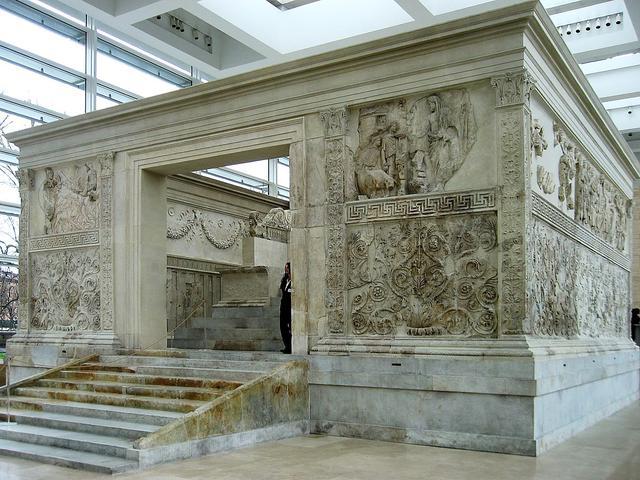Monument of Peace

The Ara Pacis Augustae, also known as the Monument of Peace, is a stunning altar located in Rome that was dedicated to Pax, the Roman goddess of Peace. Commissioned by the Roman Senate in 13 BC to commemorate the return of Emperor Augustus to Rome after his successful campaigns in Hispania and Gaul, the monument stands as a symbol of prosperity and abundance during the Roman era. Situated originally on the outskirts of Rome, the Ara Pacis was later relocated to its current location at the Ara Pacis Museum in 1938, where visitors can marvel at its intricate design and historical significance.
The altar itself is surrounded by beautifully sculpted enclosure walls made entirely of Luna marble, showcasing detailed reliefs that depict scenes of Roman life and culture. The lower register of the frieze features intricate plant work, symbolizing the wealth and prosperity brought about by the Roman peace that Augustus sought to establish. This artistic representation not only serves a decorative purpose but also conveys a deeper message of civic duty and allegiance to the Roman Empire.
As a significant piece of Roman civil religion, the Ara Pacis Augustae serves as a testament to the power and influence of Augustus and his regime. The monument was designed not only to honor the return of the emperor but also to promote his vision of peace and stability throughout the empire. Through its elaborate architecture and detailed sculptures, the Ara Pacis stands as a lasting tribute to the ideals of Roman culture and the legacy of Augustus as a ruler.
Visitors to the Ara Pacis Museum can immerse themselves in the rich history and artistry of ancient Rome, exploring the intricate details of the monument and gaining a deeper understanding of its cultural significance. Whether admiring the craftsmanship of the Luna marble or studying the symbolic imagery of the reliefs, the Monument of Peace offers a unique glimpse into the world of the Roman Empire and the enduring legacy of Emperor Augustus. Don't miss the opportunity to experience this iconic piece of Roman history and discover the beauty and meaning behind the Ara Pacis Augustae.
© ChatGPT 3.5
The full name of the altar was Ara Pacis Augustae, thus associating Augustus directly with the establishment of peace throughout the Roman world.
The new Ara Pacis Museum in Rome opened in the spring of 2006. The museum was designed by international architect Richard Meier and has been the subject of much controversy and criticism. The Ara Pacis, a more than 2,000-year-old "Altar of Peace" that was (paradoxically) used for sacrifices, is a dominant work of Roman art and architecture that had been lost to civilization for centuries.
The outer walls of the Ara Pacis are divided into allegorical and pseudo-historical relief panels in the upper register, while the lower register is compared to scenes from nature: harmonious, intertwined vineyards containing wildlife and connoting nature under control.
Nicolai Ouroussoff of the New York Times called the building "a contemporary expression of what can happen when an architect fetishizes his own style with a sense of self-aggrandizement."